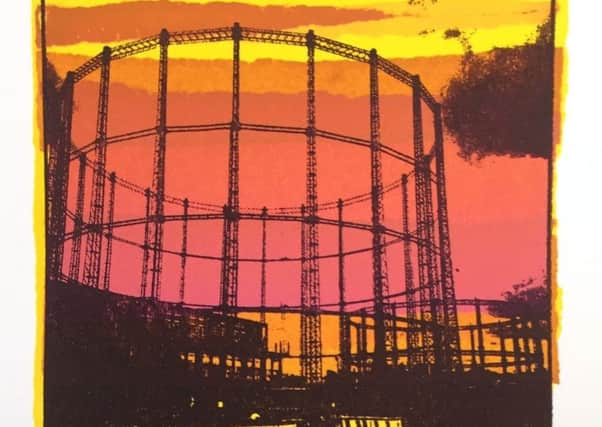How Sheffield steel inspired Human League's Martyn Ware's new art exhibition


The heavy clang of steel is not a sound associated with the pristine electro pop of groups such the Human League and Heaven 17. However, Martyn Ware, a founding member of both pioneering Sheffield bands, has a life born from the heat and sweat of the steel mill as much as he does the glitz and glamour of the music industry.
It’s a part of his life which he is now exploring in a new exhibition called POWER in collaboration with artists Sarah Hopkins and Tracey Moberly and he says it was a trip to his father’s workplace, Thompson & Sons, aged nine that made him realise what he wanted to do or, more importantly, what he didn’t want to do.
Advertisement
Hide AdAdvertisement
Hide Ad“As we approached the works, the air became thick with the smell of powdered steel and the sound of metal on metal – grinding, hammering, forging, buffering – this was a powerfully memorable soundscape for a young boy who had been shielded from the reality until this point,” he says. “When we went in the noise became almost unbearable but in those days, the mid 1960s, the hard fought for rights of workers to wear ear defenders and masks to stop the inhalation of steel dust had not yet been won.
“Inside, light was sparse, the air was full of steel and oil and cigarette smoke, the floor was rough and black and oily, the noise was deafening and dangerous machinery was everywhere. It was at this exact moment that I decided that whatever happened, I would never work in such a terrible place. The truth is, I think that was the reason my father took me there.”
Ware went on to be one of Sheffield’s most successful musicians before creating Illustrious, an organisation that explores the possibilities of 3D sound technology and the POWER exhibition will take place in the suitably industrial setting of Trafalgar Warehouse.
All three artists grew up around industry, with steel being a backdrop to their childhoods.
Advertisement
Hide AdAdvertisement
Hide Ad“I’ve spent my whole career as a printmaker, focusing on industrial and urban landscapes. I have a passion for industrial architecture,” Hopkins says. “Like Martyn and Tracey, growing up in an industrial environment, it influenced everything I created. All of our Dads worked in steel and one of my earliest memories is going to see Father Christmas at a steel works party
With Hopkins and Moberly both having roots in Wales, the project is as much based on the steel industry and community of Port Talbot as it is Sheffield. “My now deceased father was a stonemason and bricklayer,” says Moberly. “When I was staying part-time in Swansea and traveling there on the train from London I would pass the length of Port Talbot Steelworks several times a week. My father was part of a team that had built the extension on the steel works and I would think of this and his sweat and toil still existing within the bricks and mortar and muse over the generations of ancestors that would have mined the coalfields to feed the beast that I passed by.
“I love the beauty of both industrial and decaying industrial landscapes and how nature decides to combat the scars that were left behind by the industry. The socio-political and economic structures that are made and left behind and those that still function.”
Moberly and Hopkins are also hoping that their input into the traditionally male-dominated industry will add a new dynamic to the exhibition which will also explore what that industry means in current times.
Advertisement
Hide AdAdvertisement
Hide AdWare says: “There is still room and need for steel manufacturing, particularly specialist steels.” It’s a feeling which is also echoed by Moberly.
“It’s about the importance of manufacturing to a nation. It’s about fossil fuels, the environment and the battle between them both. It’s about how we have lost so much of our industrial heritage and how we can capture it. I feel that this is only the very beginning of our collaboration and journey through the steel industry.”
Hopkins says that the trio have already begun to look at ways to explore this concept further.
“We plan to develop this project. Trafalgar Warehouse is the official exhibition launch and the first of its kind but this partnership will grow and evolve and so will our project.
Advertisement
Hide AdAdvertisement
Hide Ad“We hope to bottle Sheffield, Port Talbot and maybe other industrial towns. We’re even planning to create fragrances, what you might call an essence of those places. We’ve already made preliminary visits to Berlin, where we will work with a smell artist and scientist.”
After Sheffield, the exhibition will go on a mini-tour.
“We are exhibiting in Llanelli next,” says Moberly. “And we are hoping to take it to a disused power plant in Iceland. We have enough material to work on it for a lifetime.”
For Ware, it’s also a significant tribute to the people, place and a profession.
He says: “This exhibition commemorates the dignity of their labour and the loss of the tight-knit communities that followed the closure of many of the steelworks.
Advertisement
Hide AdAdvertisement
Hide Ad“It also celebrates the spirit of pride in the making of steel and the resourcefulness of the workers’ families. It’s about the heart of post-industrial cities, which are still finding new ways to reimagine the historical skills that are literally in their DNA, our DNA. Sheffield and Port Talbot will survive and thrive because of the pride and inventiveness of their people. The beauty and legacy of the steel industry and its community will always be with us and we will never, ever, forget.”
POWER, Trafalgar Warehouse, Sheffield, to April 13.